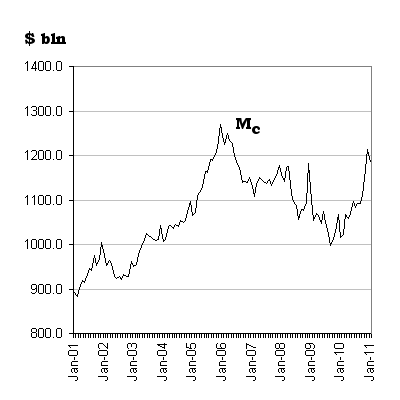23 April 2011
Real goods and services have a variety of use-values. Bread feeds us, houses shelter us, clothes warm us. Like Tolstoy's happy families, on the other hand, financial assets are all alike. Insofar as they are financial assets, they have a single use-value associated with them: the possibility that their prices will rise. People buy real goods and services to satisfy real needs. They buy financial assets (tulips, South Sea stock, bonds, houses) with only one expectation: that their prices will go up.
Real goods and services obey the law of demand and supply. When the price of bread goes up we buy less bread and more rice instead, assuming that the price of rice hasn't also gone up. When the shares of Wonderful Widgets go up, we buy more of them in the expectation that the price will go up further.
Real goods and services are bought once and consumed once, even if it is over an extended period of time. Financial assets can be bought and sold over and over again.
But there is a third difference and it is on this that I shall dwell at length.
Wonderful Widgets has a great idea to make the most wonderful thing after apple pie. It takes a bank loan and sets about beginning to manufacture it, using real goods and services. Assuming that the economy is at full capacity, this reduces the real goods and services available to other firms. Some of them have real customers and real profits today, not hypothetical ones in the future like Wonderful Widgets, and they bid higher prices for the real goods and services that Wonderful Widget is now laying a claim to. So Wonderful Widgets has to mobilise additional financial resources from elsewhere if it has to go ahead with its plans. If it cannot it has to abandon its plans. If it does manage to persuade banks or investors to fork out more money it can go ahead. But since it is calling on real goods and services, those goods and services will not be available to other firms, and they have to cut back on their own investments. So the economy has a tendency to self-correct malinvestments in the manufacture of real goods and services because these malinvestments reduce the resources available to other firms and thus exact an immediate cost.
Not so with financial assets. A share of Wonderful Widgets is just a piece of paper or an electronic entry in a computer. Buying more shares of Wonderful Widgets (and doing this a hundred times over) does not reduce the real goods and services available to other firms in the economy. All it requires is other bits of paper called dollars or other electronic entries in computers. If banks are willing to extend new loans for the purchase of shares the price of Wonderful Widgets can go up for an extended period of time without having any effect on the real economy. The only immediate effect will be an increase in money supply. Some people may spend part of the profits from the sale of shares and this may cause inflation or, more likely in our day, fuel imports. But most of the profits are likely to be reinvested in the mania.
As exuberance spreads more and more people borrow money to buy shares of Wonderful Widgets, and its price goes up further, inducing more people to buy and so on. Since there is not much negative effect on the real economy, the bubble can persist for a long time. As far as the real economy is concerned a financial bubble is costless. The effect is a steady rise in the money supply, up a gentle slope at first and then steeper and steeper. When reality strikes, the price of Wonderful Widgets descends, much faster than it went up. The effect on money supply is starker. Where it went up a slope, it falls off a precipice as no new loans are made and old loans are not paid back.
It is at this point that the financial bubble exacts its toll on the real economy. The banking system can create money out of nothing. But when the bubble bursts banks' assets get wiped out leaving their liabilities intact. So banks have to curtail lending, not only to speculators but also to firms producing real goods and services. And that sets off a recession.
The figure below shows corrected money supply from 2001 to 2011, with every sign that a new asset bubble is in the process of formation right now.

Category: Economics
